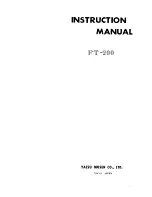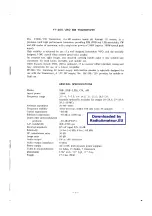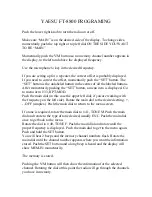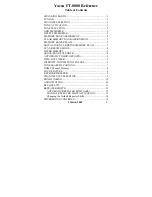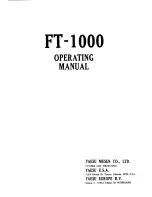
(2) Microphone Jack
This 8-contact modular jack accepts trans-mit audio, tone cali (burst) or dial/memory
selection and scanning control from the mi-crophone, and provides receiver audio for a
speaker/mic. Memories can be copied to and from another ÍT-2400H through this jack,
and a packet tnc can be connected.
(3) SQL Control
This control sets the threshold level at which a received signal (or noise) opens the
squelch and can be heard. For máximum squelch sensitivity set this control from counter-
clockwise just until noise is silenced (and the "BUSY" indicator on the display is off)
when the channel is clear.
(4) VOL Control
This control adjusts the volume of the receiver audio and of the button beeper.
Function Buttons (behind flip-down door)
To open the flip-down door, pry the right edge (next to the selector knob) out gently with
a fingertip. To close the door, press upwards on the bottom edge of the door at its center.
Do not try to cióse the door by pushing from the front.
The five buttons behind the door control most of the programmable features. If the beeper
is enabled, one or more beeps will sound when a button is pressed, if the resulting
command is accepted. The white label shows the primary function of each button.
However, if you press the F/W button first, these buttons will perform altérnate functions.
On three of these, the alternate function is indicated by the blue label on or beneath the
button. These are described in the Operation chapter.
For descriptions in this manual, we refer to alternate button functions by preceding the
button name with "F/W —>" to remind you to press the F/W button first. For example,
"F/W —> LOW LOCK" indicates that you should press the F/W button followed by the
LOW LOCK button (within five seconds).
(5) RPT Button
This button toggles repeater shift: + (up), - (down) or off. The altérnate function displays
shift offset and ARS status.
(6) TONE Button
This button toggles the CTCSS (subaudible tone) features: encode (on transmission only),
encode/decode (on both transmission and reception), and off. If the optional FTS-17A Tone
Squelch Unit is not installed, only encode and off modes are available. The altérnate function
displays the CTCSS tone fre-quency and button beeper status.
(7) PAGE CODE Button
This button activates DTMF paging (or code squelch) if the FRC-6 Paging/Code Squelch
option is installed. The altérnate function displays DTMF Code Memories.
(8) CALL / BELL Button
(9) Press this button to jump to and from your CALL channel memory. The altérnate
func-tion toggles the CTCSS paging bell, described later.
(9) A / N STEP Button
While receiving on a memory, pressing this button toggles the display between fre-quency
and alphanumeric ñame. The altérnate function displays (and allows changing) the tuning
step size, and the scan-resume mode, as described later.
(10) Selector Knob
This 24-position detented rotary switch is used for tuning, memory selection and most
function settings. The DWNand UP buttons on the microphone duplícate the functions of this
knob.
(11) LOW LOCK Button
Press this button while receiving to toggle high/medium and low transmitter power (50/25
and 5 watts, respectively). The display shows "loh" (above the S-meter) when either low or
médium power is selected. The altérnate function of this button disables the selector knob
and most of the front panel buttons (except itself, F/W and POWER, and the microphone
buttons). Press F/W and this button again to unlock the panel.
(12) MHZ PRI Button
This button allows tuning in 1-MHz steps (the kHz digits blank on the display). If receiving
on a memory, pressing this button the first time activates the Memory Tune (MT) mode, and
pressing it again enables 1-MHz steps. The altérnate function of this button activates priority
monitoring, described in the Operation chapter ("P" displayed instead of the memory number
to the upper left of the frequency).
(13) REV SKIP Button
During split-frequency operation, such as through a repeater, this button reverses transmit
and receive frequencies. During memory operation, the altérnate function sets the current
memory to be skipped during scanning.
(14) J/ Button
This button switches operation between the two main tuning modes: dial and memory. The
altérnate function marks the current memory to be skipped during scanning. This button is
duplicated by a button on the mi-crophone in non-European versions.
(15) F/W Button
This button activates the altérnate functions (blue labels) of most of the other buttons. It
is also used to store current operating data into a memory (by holding it down for V2-sec-
ond, releasing and pressing again), and to toggle several programmable features.
(16) Display
The display segments are as shown below. The main digits on the display may show
operating frequency, memory ñame, or any of many parameters during setting, such as
tuning step size,
3
Summary of Contents for FT-2400H
Page 1: ......















